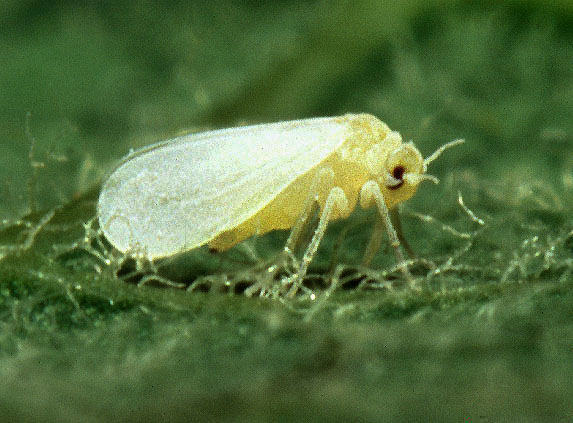
Greenhouse whitefly – or Trialeurodes vaporariorumm to give it its binomial name – is a common pest for gardeners. The insects inhabit most of the world’s temperate regions – and is a big fan of feeding on fruit, vegetable and ornamental crops.
Cucumber, melon, tomato and peppers are common victims of whitefly, as well as the likes of Chrysanthemum, Gerbera, Pelargonium, Fuchsia, Lantana, Poinsettia and Verbena.
Adult of the species can grow anywhere between one and two mm in length and are very distinctive with their wax-coated wings and yellowish bodies. The wings are typically held very nearly parallel to the leaf surface.
They are much more than just a nuisance, as their presence can be very damaging to plants. This is because they feed directly from the plant they are inhabiting – and this is usually done by inserting a stylet into the veins of a leaf and extracting the phloem sap nourishment.
Honeydew is extracted as a byproduct of this process – and this can be a significant cause of damage in itself.
The pests have a very rapid reproduction cycle, with the females able to mate less than 24 hours after they have emerged from their own eggs (which are typically laid on the underside of leaves).
As a result of this trend and in addition to the widespread occurrence of pesticide-resistant strains, whitefly can be very difficult to control. However, there are still options for the vigilant gardener. UK gardening charity the Royal Horticultural Society (RHS) states that biological control often yields better results than insecticides – adding that this is particularly the case when it comes to greenhouse plants.
Celebrity gardener and broadcaster Monty Don expressed his distaste for the use of insecticides in such circumstances. Writing in an article for UK national newspaper the Daily Mail, he noted: “Many insecticides aimed at aphids, whitefly, vine weevil or thrips seem to be the most likely to contain neonicotinoids.”
However, the expert warned: “The risk of collateral damage is too high.” Don explained: “The reason for avoiding insecticides is twofold. The first is that they are indiscriminate. They can be very effective in killing off the insects you regard as ‘pests’ but they kill beneficial insects too.” In order to combat this, he suggested “the best thing we all can do is grow plants that encourage bees and insects”.
The RHS recommneded introducing tiny parasitic wasps – Encarsia formosa – into the greenhouse in order to tackle a whitefly problem. These attack the young whitefly – and their progress is easy to monitor as the nymphss will turn from their usual white to black.
Encarsia are easily killed off by most common insecticides, so it is important that this apporach is not mixed with such a method.
Gardener’s World magazine suggested an alternative and more organic approach of hanging up yellow sticky traps to catch the adults when they are flying around. Alternatively, by growing strong-smelling plants like French marigolds alongside the fruit-based victims, the gardener could find the whiteflies are naturally deterred.


